Transgender Hair Transplants – What to Know About How They are Performed
As part of the gender transition process, a hair transplant can help a person feel as if their outward appearance is matching how they feel on the inside. The appearance of the hair plays a key role in how a person presents themselves to others including how they express their gender to the public. Keep reading to learn how a hair transplant is performed and how it assists in a transgender medical procedure.
Hair Transplant – What is it?
A hair transplant can be described as a surgical procedure that addresses balding or thinning areas on the scalp of a patient. The surgery involves the doctor moving hair grafts from (usually) the donor area on the scalp which is the hair located on the back and sides of the scalp. The hair in this area is resistant to balding which is why a surgeon generally chooses this section of hair to transplant into the targeted area on the scalp.
Gender-Affirming Care – What Does it Mean?
 Gender-affirming care is medical care that is intended to improve the well-being of a person whose gender identity does not match the sex they were assigned at the time of birth. In addition, gender-affirming care can help a person live a more comfortable life, minimize their ongoing distress and/or discomfort and allow them to live their life as their most authentic self.
Gender-affirming care is medical care that is intended to improve the well-being of a person whose gender identity does not match the sex they were assigned at the time of birth. In addition, gender-affirming care can help a person live a more comfortable life, minimize their ongoing distress and/or discomfort and allow them to live their life as their most authentic self.
As part of their gender-affirming care, some patients decide to have a transgender hair transplant. Depending on the goals of the patient and their gender identity, there are multiple hair transplant options that can be performed to alter and enhance their hairline and encourage hair growth in other areas of the body. These hair transplant options include:
- Crown restoration works to promote new hair growth in a section of the scalp that is thinner due to male pattern baldness
- Hairline lowering/Hair feminization is performed to give the hairline a more feminine appearance through the lowering of the hairline and the creation of a rounder shape to the hairline
- Facial hair restoration/Chest hair restoration encourages hair growth on the face that is thicker and more visible as well as boosting the growth of hair on the chest
Even though these hair transplant techniques are often discussed in terms of giving someone a look that is more masculine or feminine, the sense of gender of a person is unique to them so the ultimate treatment choice is any combination of hair transplant procedures that enables someone to feel comfortable about their appearance and identity.
Hair Transplant – How it is Performed
The most popular hair transplant technique is Follicular Unit Extraction (FUE) as this technique does not require the removal of a strip of skin from the scalp. Instead, the hair grafts are individually harvested from the donor area by the surgeon so there is no need for the creation of a linear scalp scar.
Before the procedure is performed, the surgeon designs the new hairline while keeping the existing hairline and the desired results in mind. At the start of the surgery, a local anesthesia is applied to the donor and recipient areas so the patient will remain comfortable during the surgery.
The surgeon creates sites in the scalp by making incisions where the hair grafts will be implanted in the head. The hair follicles are then removed on an individual basis from the donor area and implanted into the sites.
The cost of the surgery depends on a number of factors including the number of hair grafts needed to achieve the new look to the scalp, the cost per hair graft charged by the surgeon, the area of the country where it is performed, and any additional fees charged by the doctor or the medical facility.
Transgender Hair Transplants – How to Find the Right Surgeon
Patients need to research surgeons who are experienced in performing transgender hair transplants in order to locate the right doctor for their specific needs. Once the patient finds a surgeon they want to visit, it is time to schedule a consultation appointment to meet the doctor in person and to be examined by the surgeon.
During the consultation appointment, there are a number of questions that the patient should ask in order to get a better idea about the skill level of the surgeon. Some of the most common questions include:
- What is the level of experience on the part of the doctor in performing transgender hair transplants?
- Am I an ideal candidate for the surgery?
- Are there “before and after” photos of past patients that I can view?
- What kind of results can I expect to see?
- What are the possible risks and complications of the surgery?
The doctor will also examine the patient to make sure they are healthy enough to have the procedure and that the person clearly understand the extent of the changes that can be made by undergoing a transgender hair transplant.
Buzz Cut – Does it Assist in Hair Growth?
Harry Styles is a singer and international superstar who is known for his music, his sense of style, and his wavy brunette hair. Styles is also known these days for throwing his fans into a state of shock after he debuted a new hairstyle that is best described as a close buzz cut.
Buzz Cut Harry – New Harry Styles Look Generates Google Searches
Earlier this month, the speculation about Styles changing the look of his hair was all over celebrity gossip websites. The gossip was confirmed on November 9th when the singer attended a show in Las Vegas by U2. In a video from the show, Styles is seen having a fun time at the event and sporting a head that was freshly shaved.
Styles is not the only celebrity who has ditched their trademark hairstyle for a buzz cut. Additional examples from this year include Florence Pugh at the Met Gala and Bradley Cooper out in New York with a closely shaved head.
Once the news broke about Harry and his new hairstyle, Google searches for “how to shave head” increased by 84% according to a search analysis by GetHair in the United Kingdom. In addition, the number of views of videos on TikTok that included the hashtag, #harrystylesbald, has passed five million since the launch of the hashtag.
Buzz Cut – More Than a Low Maintenance Hairstyle?
 Besides being a fashionable hairstyle choice, there are some who want to get a buzz cut because it means less time taking care of their hair. Plus, there are others who get a buzz cut in the hope that their hair will be “reset” when it grows back and aid hair that has been damaged or lost in the past due to hair treatment choices such as heat styling or an excessive amount of bleaching.
Besides being a fashionable hairstyle choice, there are some who want to get a buzz cut because it means less time taking care of their hair. Plus, there are others who get a buzz cut in the hope that their hair will be “reset” when it grows back and aid hair that has been damaged or lost in the past due to hair treatment choices such as heat styling or an excessive amount of bleaching.
While the desire to “reset” their hair is on the minds of some who get a buzz cut, does this actually happen?
The first thing to keep in mind when deciding on a buzz cut is having a good idea how long it will take the hair to grow back after the haircut. Depending on the length and amount of hair that is cut, it can take up to a year for the hair to fully grow back to its previous length. Even though a professional hair stylist can make dramatic changes to the look of the hair, many people decide to perform the task on their own and give their hair a look that is close and neat.
Another reason many people decide to go for a buzz cut is the idea that the hair will grow back thicker and stronger than it was before the haircut. Unfortunately, this is simply a myth that makes many believe their hair will be healthier and stronger once it grows back. Yes, the close shaving of the head will remove the hair that has been damaged by bleaching or heat styling (as discussed earlier in this article). However, the hair that grows back after the buzz cut will not be much improved if the person simply decides to treat the regrown hair the same way they treated the older hair that was removed by the buzz cut.
Instead, a person should follow a diet that is full of nutrients for healthy hair such as zinc, protein, iron, and vitamins A, C, D, and E. If these nutrients are not consumed on a regular basis as part of a healthy diet, shaving the hair on the head will not result in the appearance of a healthier head of hair.
If the desire to “reset” the hair is also a wish to see hair regrowth, a buzz cut will not magically make room for new hair to replace hair that has been lost due to genetics, the continued wearing of a certain hairstyle, an infection, or medications. Instead, the person who has lost their hair should consult with a board-certified hair transplant specialist to see if they are an ideal candidate for a hair transplant that can rejuvenate the hairline and give it a fuller and thicker appearance.
The quality of the hair on the head is determined by the makeup of the body as well as the cells in the body. The hair quality can also be impacted by anxiety and stress along with the lack of proper nutrients in a diet. These factors have an impact on the quality of the hair as opposed to shaving the head for a buzz cut hairstyle.
Buzz Cut – The Start of a Hair Transition
While shaving the hair on the head will not result in hair that is thicker or healthier, it will provide a person the opportunity to experiment with various hairstyles while the hair is growing. A person who performs a buzz cut on their hair might think the hair is gaining a thicker look, but this is a misconception. They are actually viewing the widest part of the hair shaft, so the hair is not thicker when it is growing back.
Hair Loss – Can Psoriasis Cause It?
A person who has a look on the scalp that is silvery and scaly in appearance might be suffering from scalp psoriasis. If this is the case, the scalp might experience some discomfort and itching. In addition, scratching the scalp to try and find some relief might lead to a temporary loss of hair. Thankfully, there are some treatment options that can help a person clear up the condition while also reducing the level of scalp irritation and stopping the amount of hair loss.
Scalp Psoriasis – What is it?
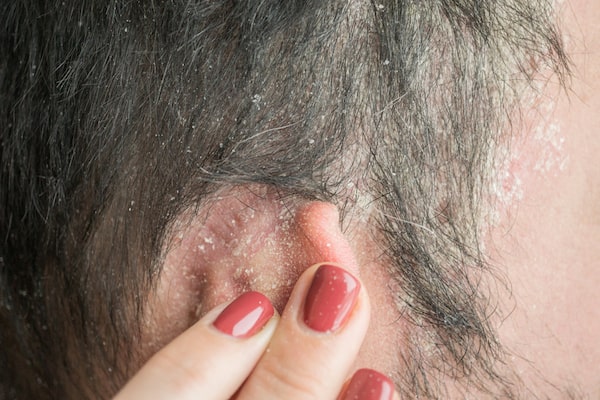
Psoriasis is a skin condition that is caused by the cells of the skin being turned over too quickly by the immune system. The result is the formation of plaques (silver scales) and scalp patches that are red in appearance.
If a person is experiencing psoriasis, they might develop the condition on the scalp. According to the American Academy of Dermatology, at least 50% of those who have plaque psoriasis will also develop psoriasis on the scalp. If this starts to appear on the scalp, the condition can range from mild to severe including cases of light scaling as well as thick plaques. In addition, psoriasis can be seen as a small patch on the scalp or as a condition that covers the entire area of the scalp.
Psoriasis – Reasons for Temporary Hair Loss
Even though psoriasis on the scalp can cause hair loss to occur, the amount of hair loss is only temporary. If a person decides to scratch their head to try and relieve the amount of itching caused by scaling, the hair in the area of the scalp being scratched can fall out. Plus, a person who tries to remove the scales in a forceful manner can also see some hair loss. However, once a successful treatment is found for the psoriasis, the hair that was lost will grow back.
In order to prevent itching on the scalp, patients are advised to use a conditioner that moisturizes the scalp and also limit the use of blow dryers that place heat on the scalp. Keep in mind that a breakout of psoriasis likely cannot be completely prevented but the condition can be managed if patients talk to their doctor about ways to address the condition.
Psoriasis – Treatment Options
There are multiple methods that can be used to treat scalp psoriasis. In order to find the best treatment option for their specific condition, a patient should meet with a doctor who specializes in the condition.
 The doctor might prescribe a topical treatment that contains antimicrobials or vitamins A and D while also requiring a prescription. Vitamin A has a direct impact on how quickly skin cells are able to grow and divide while vitamin D impacts cell growth and the functioning of the immune system. There is also a school of thought that an increased amount of vitamin D is able to help in the treatment of psoriasis. Antimicrobials might be prescribed by the doctor if the medical professional suspects the presence of a yeast infection.
The doctor might prescribe a topical treatment that contains antimicrobials or vitamins A and D while also requiring a prescription. Vitamin A has a direct impact on how quickly skin cells are able to grow and divide while vitamin D impacts cell growth and the functioning of the immune system. There is also a school of thought that an increased amount of vitamin D is able to help in the treatment of psoriasis. Antimicrobials might be prescribed by the doctor if the medical professional suspects the presence of a yeast infection.
Steroids are also used on a regular basis to treat the issue of scalp psoriasis. Steroids are useful in reducing the redness of any lesions along with reducing the amount of inflammation and swelling. The types of steroids used include creams and injections and the actual treatment plan is determined by a board-certified doctor. The doctor will prescribe doses of oral steroids in moderation while injections of steroids will only be administered every three or four months.
If the psoriasis on the scalp is severe, the doctor might inject the steroids directly into the impacted area. If these injections are not prescribed, the doctor might prescribe an oral medication such as oral retinoids, methotrexate, or apremilast.
Another commonly performed treatment for psoriasis is the use of injectable or infusion therapies for psoriasis diagnosed as moderate to severe. The injectable or infusion therapies include biologic agents and some common examples (and their brand names) include Humira, Cosentyx, Stelara, and Taltz.
Many doctors also recommend a lifestyle change on the part of the patient as lifestyle changes have a possibility of treating scalp psoriasis when the changes are made in combination with a recommended treatment from a doctor. Some of the lifestyle changes that are often suggested by a doctor include avoiding scratching the scalp as this can result in hair loss, a reduction in alcohol intake as this can cause psoriasis flares, and a reduction in stress levels as this can also result in psoriasis flares that make the condition worse.
No matter the reason for the condition or the severity of the scalp psoriasis, it needs to be treated with the help of a doctor, so it does not continue to impact the scalp. Once the doctor has determined the proper treatment plan, the scalp psoriasis will more than likely improve, and the patient will experience a regrowth of their hair.
We invite anyone reading this article who is experiencing scalp psoriasis to contact our office today for further information and to schedule an appointment with one of our doctors.
Hair Restoration – What Patients Should Know
As a person ages, there is a chance that their hairline will start to recede and this condition impacts millions of people each year in the United States. The condition known as androgenetic alopecia is also referred to as male-patterned baldness and female-patterned baldness. Let’s take a look at how balding starts to appear on patients and some of the most popular and effective hair loss treatment options currently performed by hair restoration specialists across the country.
Hair Loss – Is it the Same for All Genders?
When men start to experience changes to the hairline from androgenetic alopecia, the loss of hair usually begins at the front of the scalp and the hairline will continue to recede.
On the other hand, women who experience androgenetic alopecia tend to exhibit a more diffuse and general amount of hair loss on the scalp. This means their loss of hair is seen as a decrease in the volume of hair density throughout the entire scalp.
Hair Restoration – Natural Hair Loss Treatment Options
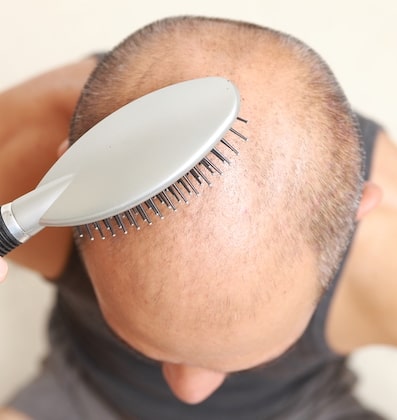 Some patients inquire about so-called natural remedies that have been advertised as being able to reduce the loss of hair. A partial list of natural remedies patients ask about includes peppermint oil that contains menthol as this has been said to increase the circulation of blood to the scalp, biotin supplements that some claim restore and regrow the hairline by using biotin to convert food into energy, and a scalp massage to increase the flow of blood to the scalp for increased hair regrowth.
Some patients inquire about so-called natural remedies that have been advertised as being able to reduce the loss of hair. A partial list of natural remedies patients ask about includes peppermint oil that contains menthol as this has been said to increase the circulation of blood to the scalp, biotin supplements that some claim restore and regrow the hairline by using biotin to convert food into energy, and a scalp massage to increase the flow of blood to the scalp for increased hair regrowth.
As great as all of these ideas sound, there is little in the way of hard evidence to suggest these options provide the desired results.
Hair Restoration – Over-the-Counter Medications
While minoxidil was originally used as a drug to treat hypertension, it is most popular these days as a medication that can be applied to the scalp as a foam or taken as a pill on a daily basis. The total amount of hair regrowth varies per patient, but it is not a permanent hair loss cure. Minoxidil, which is commonly referred to by the brand name Rogaine, can slow down the rate and amount of hair loss but it only works as long as the patient is committed to taking it on an ongoing basis. Once the person stops using the medication on a regular basis, the hair will eventually gain its pre-minoxidil look.
Finasteride, which is also known by the brand name Propecia, is a medication that comes in the form of an oral tablet. It is known for stopping androgenetic alopecia by increasing the testosterone of the patient. It is mostly recommended for use by male patients as finasteride has been shown to cause birth defects in women who are exposed to it while they are pregnant. Like minoxidil, the results of finasteride are not permanent, and they will start to fade away once the use of the medication is discontinued by the patient.
Hair Restoration – Hair Transplant Surgery
If a patient is looking for a surgical method of treating hair loss, they can often turn to a hair transplant to restore and improve the appearance of their hairline. Hair transplant surgery uses hair grafts from the body of the actual patient to promote the growth of hair in the thinning and balding areas of the scalp.
The hair grafts are normally taken from the donor area of the scalp which is considered to be the back and sides of the scalp. The hair in this area of the scalp has proven to be resistant to balding and it acts like the native hair on the scalp when it is transplanted by the surgeon to the treated area.
The amount of hair grafts that are needed to provide the desired amount of hair density varies by patient. If there are not enough quality hair grafts to transfer into the thinning or balding areas of the scalp, the doctor can use hair from elsewhere on the body (such as the chest or beard) to gain enough hair grafts to transplant into the scalp.
Hair Restoration – How to Know When to Have a Treatment
There are some people with hair loss that have given up hope of ever gaining an improved hairline. The hair can be a major part of the identity of a person and a person can have issues with their self-image and not have any confidence in their appearance.
If someone is not sure if any positive changes can be made to their hairline, they should schedule a consultation appointment with a board-certified doctor who is experienced in performing hair restoration surgery. The doctor can examine the scalp of the patient to identify the reason for the hair loss and also determine the best plan of action to address and treat the hair loss on the scalp.
Can I Lose My Transplanted Hair?
One of my favorite aspects of interacting with the public is answering questions on Reddit during an AMA (Ask Me Anything) session. It allows me to chat and answer questions from those that want to learn more about hair restoration but might not be sure how to begin the hair transplant process. I conduct an AMA session every three months and my latest AMA took place this past week.
Each AMA session contains interesting questions from people across the country. I’d like to share one of the most interesting questions that was asked during our last Q&A. Keep reading to learn more about the possibility of hair loss after a hair transplant procedure and check out one of my videos on the topic:
Reddit AMA – Question About Hair Loss after a Hair Transplant
A patient who had two hair transplants in the past was questioning whether the transplanted hair is always permanent as he has lost a lot of hair two years after the first surgery. He mentioned that he thought the hair loss was not grafted hairs but native hairs that were susceptible to further loss.
Once he received his second hair transplant, he thought that he started to lose grafted hairs in the frontal hairline from both procedures. He mentioned this was a year after his second surgery, so it was not like the grafts fell out prematurely. The transplant worked and then, a year later, his hair started to fall out. What could be the cause of grafted hairs falling out a year after surgery?
As I said earlier, this is one of the most interesting questions as it is a topic that is on the mind of many patients who visit our office for a hair transplant consultation. They want to know if there is a possibility that they will lose hair on their scalp anywhere from immediately after the surgery to a year (or beyond) after the procedure.
Here are some of the causes of hair loss after a hair transplant, that I shared on Reddit, in greater detail:
- Losing Native Hair in the Area:
We certainly don’t expect the transplanted hair to fall out. There are different conditions that may contribute to the loss of your volume of hair after a hair transplant. As the patient mentioned, he may have lost the native hair that was present before transplantation.
- Asynchronization of Hair Growth Cycles:
Scalp hair is always going through different phases like growth and resting. On average 15% of our scalp follicles are always resting. That means we lose hair shafts on those follicles until they start to grow again. After a hair transplant, we lose hair shafts on all grafts after the first month which means we artificially induce a resting phase. At the one-year mark, we usually see 100% growth since all the hair is out and all of the follicles are in the growth phase. After the first year, the cycling of hair starts to become asynchronized which means some of the transplanted hair may go to sleep. The amount could be as high as 15% of the hair. These grafts are not gone, but the hair has entered the resting phase. As these hairs grow back in 4-6 weeks, others may fall out, so it can be expected to see a decline in volume after the first twelve months.
- Cicatricial Alopecia:
In rare cases, other skin conditions like cicatricial alopecia may cause hair loss. If this is a possibility, the patient should be evaluated by the operating physician with a scalp biopsy and proper treatment can be started for the condition.
- Senile Alopecia:
There is another relatively rare condition, seen in older people with male patterned baldness, where the donor hair gets thinner. This senile hair loss could happen everywhere including the areas that are used as donor hair for transplantation. If someone has the gene for senile hair loss, the transplanted hair may start to thin out the same as the native hair, but this condition does not happen until an older age.
- Other Causes:
People may lose hair for a variety of reasons like scarring, autoimmune disorders, skin conditions like alopecia areata, excess manipulation, or the hair being pulled in certain hairstyles. In general, normal hair and transplanted hair are not immune to these factors.
Hair Transplant – Are the Results Permanent?
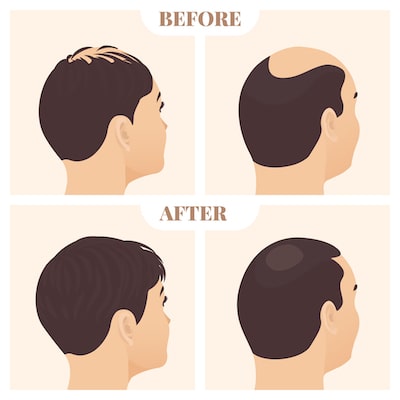 The first thing to know about a hair transplant is that the results are permanent in the area of the scalp treated by the surgeon. There is a general possibility of hair loss in the scalp after a hair transplant, but this does not include the area of the scalp where the hair transplant was performed. The other areas of the scalp that were not treated by the placement of hair grafts in currently visible thinning or balding sections can continue to lose hair. In addition, there might be sections on the scalp that were not treated in the past that could show hair loss in the future.
The first thing to know about a hair transplant is that the results are permanent in the area of the scalp treated by the surgeon. There is a general possibility of hair loss in the scalp after a hair transplant, but this does not include the area of the scalp where the hair transplant was performed. The other areas of the scalp that were not treated by the placement of hair grafts in currently visible thinning or balding sections can continue to lose hair. In addition, there might be sections on the scalp that were not treated in the past that could show hair loss in the future.
This does not necessarily mean that additional hair loss will occur after a hair restoration procedure, but it is something that patients need to keep in mind as they consider the possibility of surgery. Plus, as mentioned in my answer on Reddit, there is a chance of a skin condition causing hair loss in the future. This hair loss cause might not be evident (yet) while examining the scalp during the consultation appointment for the initial hair transplant.
Does it sound like we might be going back and forth on the answer? We are certainly not trying to “have it both ways.” It is simply important for patients to know that the results of any type of medical procedure are not 100% certain. However, between the diagnosis made during the consultation appointment and the hair transplant surgery, our team of experienced and board-certified surgeons are ready to provide long-lasting results that are natural in appearance.
Thinning Eyebrows – Can Minoxidil Treat This Condition?
Hair loss is most often thought of as hair that is lost on the scalp, and this can result in a look that is thinning or balding on the head of a person. This is not the only area of the head where hair loss can occur as a loss of hair can also happen in the eyebrows which gives a sparse appearance to this area of the body. Let’s take a look at why eyebrow hair can be lost and if minoxidil can address the condition.
Thinning Eyebrows – Why They Happen
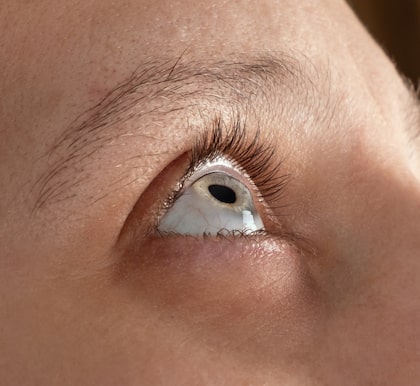 There are multiple reasons why hair in the eyebrows can start to experience hair loss and they include both medical issues and lifestyle choices. Some of the most common eyebrow hair loss causes include over-plucking the eyebrows, alopecia areata, deficiencies in the daily nutrition of a person, and hormonal imbalances. The actual cause of the hair loss in the eyebrows will be determined by a board-certified doctor during a consultation appointment. The doctor should be experienced in identifying hair loss conditions and treating the issue and these medical professionals include hair restoration specialists and dermatologists.
There are multiple reasons why hair in the eyebrows can start to experience hair loss and they include both medical issues and lifestyle choices. Some of the most common eyebrow hair loss causes include over-plucking the eyebrows, alopecia areata, deficiencies in the daily nutrition of a person, and hormonal imbalances. The actual cause of the hair loss in the eyebrows will be determined by a board-certified doctor during a consultation appointment. The doctor should be experienced in identifying hair loss conditions and treating the issue and these medical professionals include hair restoration specialists and dermatologists.
Minoxidil – Can it Be Used on the Eyebrows?
When it comes to treating hair loss in the eyebrows, as well as on the scalp, many patients turn to minoxidil as it is an FDA-approved treatment for thinning hair.
Minoxidil is also known by the brand name, Rogaine, and it was first developed as an oral medication to treat blood pressure. However, it was also discovered that the medication had the unexpected side effect of being able to stimulate the growth of hair. It should be noted that, even though minoxidil has been in use for many decades, the exact mechanism of the action for the medication is still not understood fully by the medical community. There is a school of thought that says, because minoxidil is a vasodilator, it is able to widen blood vessels which can help increase the flow of blood in the treated area. In other words, when minoxidil is topically applied to the scalp of a patient, it might increase the amount of blood flow to the hair follicles which helps them to enjoy a greater amount of oxygen and nutrients.
While minoxidil is approved by the FDA for use on the scalp, it is not approved for use on the eyebrows due to concerns that it might possibly cause some damage to the eyes. Having said that, can it also be used on the eyebrows of a patient? The answer is “Yes” but it needs to be used for this purpose under the professional guidance of an experienced and board-certified doctor. The doctor in question needs to have examined the scalp and learned about the medical history of the patient before making the decision to use minoxidil to treat the eyebrow hair loss condition of the patient.
Thinning Eyebrows – What Results Will Minoxidil Provide?
The extent of the results is often determined by the extent of the hair loss in the eyebrows. There are some patients who have enjoyed an improvement in the density of their eyebrow hair along with a greater amount of time in the hair growth phase (anagen). If the patient wants to enjoy eyebrows that are fuller as well as an increased number of hairs in the eyebrows, minoxidil might be the right choice for that person.
The results provided by minoxidil are not permanent which means the patient will need to be committed to using the medication on a regular basis to maintain the results. If the person decides to stop using minoxidil on a consistent basis, the results will eventually disappear, and the appearance of the eyebrows will return to their pre-treatment appearance.
A person who decides to use minoxidil on the eyebrows should not expect to see instant results as it can take several months for results to start to show in the eyebrows.
Thinning Eyebrows – Minoxidil Research Results
Back in 2021, the results from a study on the use of minoxidil on thinning eyebrows was reported by the Japanese Dermatologists Association in Dermatology and Therapy. During the study, forty-two volunteers took part in a medical investigation of the use of Rogaine to grow eyebrow hair.
The research team applied 2% minoxidil on one side of the eyebrow and a placebo on the other side. This research method was performed for a period of sixteen weeks. The results showed a significant amount of eyebrow hair growth and thickness in ninety-eight percent of the study volunteers while the other study volunteers were unaffected by the use of Rogaine on the eyebrows.
Thinning Eyebrows – Possible Risks of Topical Minoxidil
Anyone who is interested in the use of minoxidil on the eyebrows needs to know that some of the potential side effects include itchiness, burning, and irritation in the area treated by the medication. These possible risks mean the patient needs to be careful and precisely apply the medication to the eyebrows, so it is not accidentally placed on the eyes or even cause hair growth in an area like the eyelids where it is not intended to be placed by the person using minoxidil to treat thinning eyebrow hair.
Menopause and Hair Loss – Why They are Connected
When the topic of hair loss is discussed among the public, it is usually considered to be a “male condition” since hair loss news and articles are often focused on male patients. This is not always the case as many women also experience female hair loss on the scalp. Even though there are multiple reasons why women can lose their hair, this article will discuss the topic of female hair loss and why it is sometimes connected to menopause.
Menopause and Hair Loss – How it Impacts Hair on the Scalp
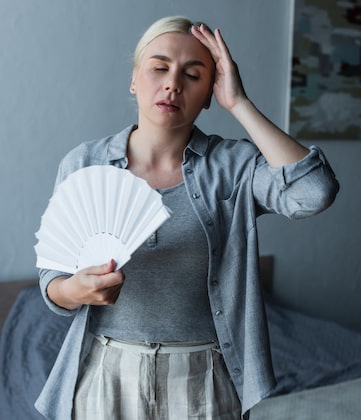 Menopause is often defined as when a woman does not have a menstrual cycle for a period of at least twelve months. However, the changes in the hormones of a female can cause a loss of hair before it is officially diagnosed (perimenopause) as well as long after the menopause process is over (post-menopause).
Menopause is often defined as when a woman does not have a menstrual cycle for a period of at least twelve months. However, the changes in the hormones of a female can cause a loss of hair before it is officially diagnosed (perimenopause) as well as long after the menopause process is over (post-menopause).
The loss of hair from menopause might not be obvious to the patient at first. In general, the first signs of hair loss related to menopause can be rather subtle in nature. These signs can include an increased collection of hair in the shower drain, a need to clean a hairbrush on a more frequent basis, and the discovery of more hair on clothes, pillows, and around the home of the person.
Since the hair loss tends to occur slowly, it can take a little while for the changes in the hairline to be seen in a mirror. Eventually, the female will start to notice thinning patches of hair in the top center of the scalp and also close to the hairline located by the forehead. There have even been instances when the eyebrows and eyelashes start to gain a thinner look and density during menopause.
Menopause and Hair Loss – When Does it Occur During Menopause
While fluctuations in the hormones are the main reason for hair loss that is related to menopause, the loss of hair can happen during any of the three stages of menopause These stages are perimenopause (the time leading up to menopause), menopause (when a woman goes twelve consecutive months without having a period), and post-menopause (from the time menopause is officially diagnosed until the end of life).
During the first stages of menopause, the levels of estrogen and progesterone in the body start to decline. Since these hormones play a part in the promotion of full and dense hair growth, the drop in their level can cause thinning hair on the scalp. In addition, the drop in these hormones also cause an increase in androgens which are male hormones that are also found in smaller amounts in women. Androgens can result in the hair follicles on the head starting to shrink and this results in a hair loss condition known as androgenic alopecia.
Menopause and Hair Loss – How to Treat the Loss of Hair
There are multiple treatment options to address the hair loss associated with menopause. Female patients can use minoxidil on the scalp to promote hair growth in women with female-pattern baldness (which can happen during menopause). The results from minoxidil are not permanent which means the hair will go back to its pre-minoxidil appearance if the patient stops using it on a regular basis.
There are some doctors who perform laser treatment, AKA light therapy, on the scalp. The focusing of low-intensity light to the scalp can trigger a reaction that serves as a signal for the growth of new hair. There is a school of thought that light therapy can increase the strength of the hair as well as the amount of hair follicles. Not all hair restoration specialists perform this treatment option, so patients need to check with their doctor of choice for more information.
The most long-lasting and natural hair restoration option is a hair transplant. If the loss of hair is severe enough, the doctor might recommend a hair transplant where hair grafts are removed from one part of the body and are then implanted into the thinning or balding areas of the scalp. The hair grafts are usually taken from the back and sides of the scalp as the hair in these areas is resistant to balding. The results of a hair transplant are permanent and the hair that is transplanted into the thinning or balding sections of the scalp grow like the hair that is native to the area.
Menopause and Hair Loss – Consult with an Experienced Hair Restoration Specialist
Patients who are not sure if their hair loss is the result of issues related to menopause should schedule a consultation appointment with a doctor who is experienced in diagnosing and treating hair loss on the scalp. The doctor will perform a thorough medical examination of the female patient to determine the reason for the hair loss, the extent of the loss of hair on the scalp, the best treatment option to address the hair loss, and if the person is healthy enough to undergo the recommended medical treatment suggested by the doctor.
New Hair Loss Solution – Injected Like Botox?
Hair loss impacts both male and female patients and the amount of hair loss can range from thinning on the scalp to a completely bald head. At the moment, the main methods of treating hair loss include having a hair transplant to restore the hairline or using minoxidil or finasteride to stop or slow down the hair loss process. This could change as new research from the University of California, Irvine, might be the start of advanced therapies that will be able to combat hair loss in the near future.
New Hair Loss Solution – What Does a Study Reveal?
The UCI research team, who published their findings in the journal, Nature, shared the process behind how pigment-generating cells that are aging in the skin can actually cause new hair within moles located on the skin. The researchers worked to examine the molecular mechanisms related to the stimulation of hair growth. Their study suggests that their research efforts might result in a microneedling technique, much like Botox, that could treat hair loss in a new manner.
According to the research team, by gaining a better understanding of the hair growth process with these specific moles, it could lead to molecular therapies for male patterned baldness or female patterned baldness.
New Hair Loss Solution – The Role of “Aged Cells” in Hair Growth
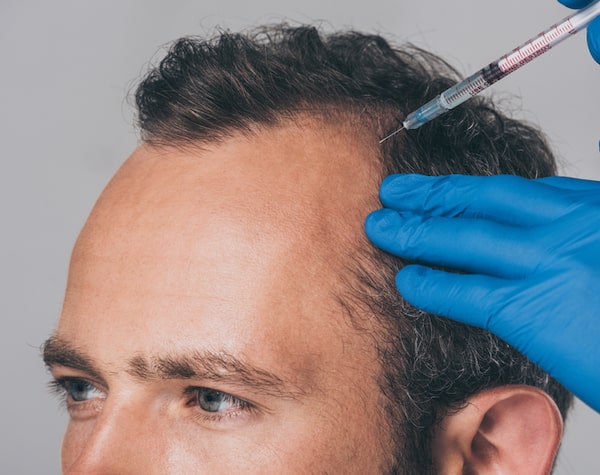 During this study, the research team examined mice possessing skin spots that showed signs of an accelerated growth of hair (similar to what has been viewed in hairy skin moles on humans). The team also took steps to examine how some of the signaling molecules impacted the stem cells to the point that hair growth occurred.
During this study, the research team examined mice possessing skin spots that showed signs of an accelerated growth of hair (similar to what has been viewed in hairy skin moles on humans). The team also took steps to examine how some of the signaling molecules impacted the stem cells to the point that hair growth occurred.
In the mice that were examined, the aged pigment cells were shown to produce high levels of osteopontin which is a signaling molecule which corresponds to CD44 (a matching receptor molecule that the mice possessed in their hair stem cells). The interactions between CD44 and osteopontin seemed to generate hair thanks to the activation of the hair stem cells.
The mice that were in possession of either the receptor molecules or the signaling molecule were examined so a control group was offered. A slower amount of hair growth was viewed in the mice that were lacking one or the other genes. In addition, the research team stated that the role of osteopontin in hair growth has also been evidenced by way of samples of hairy moles in humans.
According to Maksim Plikus, PhD, the lead author of the study, the core of the research shows that the “aged cells” are able to “exert prominent growth-promoting effects on tissue’s stem cells.” Plikus added, “Hair growing out of nevus skin often look ‘youthful,’ long and thick despite the fact that skin moles are jam-packed with ‘aged’ pigment-making cells, called senescent melanocytes. If one would follow conventional logic that senescent cells are the cause of tissue aging, then mole skin should be particularly ‘old’ – yet, what we see is vigorous, ‘rejuvenated’ hair growth.”
When compared to youthful cells, senescent cells stop dividing which means they can remain in an idle state in tissues for years at a time “without meaningfully contributing to tissue renewal by making new cells.” The senescent cells do not pose much harm, and they can even bind to the surfaces of other cells as well as modulate their behavior. They can also bind to, and trigger, the immune cells of the body. This knowledge plays a part in research on aging as “it has long been believed that exposure to senescent cell-secreted molecules is not very healthy for tissues as it inappropriately prompts their immune cells, which ultimately promotes tissue decline.”
However, this research also shows “a surprisingly positive effect” of the signaling molecules created by skin moles cells on the hair follicle stems cells that are close by and at rest. Even though these cells are associated with aging, they do play a role in triggering the growth of new hair via the osteopontin molecule.
“Osteopontin from senescent cells acts directly on hair follicle stem cells via its molecular receptor, called CD44, and it is the molecular interaction between the two genes that triggers new hair growth. Binding of osteopontin to CD44 on the surface of hair follicle stem cells sets off a molecular chain reaction in the latter — it induces changes in their gene expression and this, in turn, results in their activation. Hair follicle stem cells exit dormancy and start dividing and this initiates new hair growth.”
New Hair Loss Solution – Possible Microneedling Hair Growth Treatment in the Future?
Since osteopontin is not able to penetrate intact skin when it is applied topically (as it is basically “a large-size protein”), a product that is created based on this research would have to be micro-delivered to the skin at a depth of around 1mm AKA the depth in the body where normal hair follicle stem cells reside. “Such micro-delivery can be done via a form of microneedling technique. We envision this will be a quick, near pain-free procedure, whereas scalp skin is treated with micro-needles that efficiently deliver small amounts of molecules such as osteopontin approximately 1 mm deep.”
When it comes to further studies, the biopharmaceutical company co-founded by Plikus, Amplifica, announced the first in-human study of AMP-303 which is a compound that will be used for the treatment of androgenetic alopecia. In addition, AMP-303 does not rely on osteopontin.
The president and CEO of the company, Frank Fazio, says his team is encouraged by data that suggests AMP-303 will be an effective solution for both men and women. The first human subject began the treatment on June 27th of this year. The study is expected to be finished in the first quarter of 2024. Once this study is finished, additional clinical studies will be necessary to provide a further evaluation of the findings in human subjects.